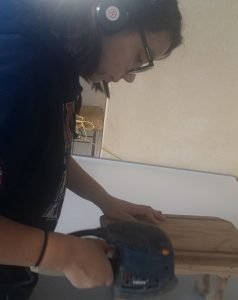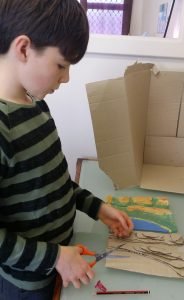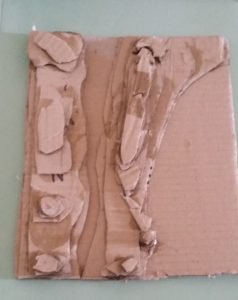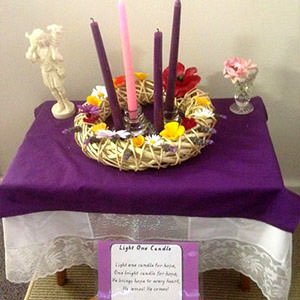by Catechist | 10 Jul 2018 | Catechesis, Characteristics
Characteristic #24 The tasks of the catechist include:
- to go deeper into the Christian message through the knowledge of the biblical and liturgical sources and of ongoing living tradition of the church, including the theological, social and ecumenical movements which enliven the church today;
- preparing an environment and maintaining order in that environment (the atrium) so that it fosters concentration, silence and contemplation in both the child and adult;
- preparing the materials oneself as much as possible while collaborating with others in areas that are beyond one’s abilities.
Part 3
Our final part in looking at the 24th Characteristic of the Catechesis of the Good Shepherd is that of materials preparation.
 A few things come to mind when thinking about preparing materials with our hands. The first is our belief in our own abilities. The second our individual skills. Thirdly our time. The fourth costs. I would like to consider each of these in this post.
A few things come to mind when thinking about preparing materials with our hands. The first is our belief in our own abilities. The second our individual skills. Thirdly our time. The fourth costs. I would like to consider each of these in this post.
Firstly our belief in our abilities. I am a person who enjoys doing things with my hands. Even when I was a child I enjoyed making things. When you make something for your own enjoyment and satisfaction, there is less pressure to “get it perfect” or for it to “work out” how you saw it in your mind. However, when you are making this for someone else or for public display, we like to get it perfect. We don’t want to let other people down or make it not fit for purpose. All admirable qualities considering these materials will be tools of the Holy Spirit!
This brings to mind the parable of the talents. It is easy to play it safe but by risking making something less than perfect we often find that God blesses us 100 fold for our effort. I think part of the challenge in having a go at making materials is our cultural belief in speaking less of our own abilities. This is somehow meant to make us appear humble. True humility is in seeing things truthfully. I think that acknowledging out gifts is as important as acknowledging our weaknesses, and for many of us both of these things are difficult.
Once we get over ourselves it is time to decide how to make materials. For most of us it is not beyond our ability to copy or trace things for the handworks. We may need to focus on our neatness in our handwriting or in getting the spacing right but overall this is one of the easier tasks. I recommend using paper and pens etc. that are of good quality or the best you can afford. This will help you to get a better result.

Woodwork is often an obstacle for people, especially when a lot of these handwork crafts have gotten lost over the years. I marvel at Sofia making all the materials by hand when she was primarily a scholar! As they say, necessity is the mother of invention! I think one of the best gifts my husband bought for me is a scroll saw. It is a little like using a sewing machine (which I have used – thanks Mum for teaching me). What it enables you to do is cut our shapes (like sheep and merchants) from pieces of wood with relative ease. Again, I suggest getting the best wood you can afford as you only want to do this once as it is time consuming and the better quality you make it the longer it will last. The cgsusa.org website has some good tips for making boxes and dioramas which I recommend you have a look at and there are also loads of youtube videos to teach yourself most skills you will need.
For some of the materials you need to sew. As mentioned I have a sewing machine and some experience. Even so, a good pattern and nice fabrics help to get a good result with this. Some of the things like vestments also need a stand. We have various stands from “T” shaped pieces of wood to papier mache busts. I suggest just take your time and let your inner engineer out and have a go as much as you can.

There are some online resources you can purchase, but I would strongly recommend to only buy ready made materials as a last resort. The children are drawn to the uniqueness of the handcrafted materials. They see so much manufactured in their world that they easily recognize the love and care that has been taken to make this just for them. It also invites them to have a go themselves. I have one level 3 child currently working on making his own raised surface map of the land of Israel.

When painting your materials recall that this material will be used for a prayerful purpose. We do not want the materials to draw the child away from the scripture (for example) that it is highlighting but rather to draw them into it. Steer clear of being too cutesy or over embellishing. This is definitely a case of less is more! However, adding elements that attract the child to the work are useful (attract not detract). It would be suitable, for example, to paint the chalice in the last supper gold, but not suitable to give characters to each of the apostles. In painting I would also recommend using a base coat to help the colours stand out from the wood and then using some clear coat to finish them off after painting in the details.
One of the costs involved in making materials is our time. We live in a time where we are used to having everything instantly. We also try to use every moment doing something and feel like we are wasting time if something takes longer than expected. I think this is one of the reasons we are encouraged to make our own materials. We get first hand experience in slowing down and being in the moment. Of pondering the works these materials help to depict. What a beautiful meditation it is to paint Mary’s house, to think of how she lived. What sort of a life did she lead? What would she have been doing in the house when the angel came to visit her? All the same questions we ponder with the children! It is the time taken to make the materials and then prepare the album pages that are the times where we prepare ourselves to proclaim the word to the children. It does take time, but like the leaven our time and work will be rewarded by growth.
The final obstacle we may have in materials preparation is that of financial cost. This is one of the biggest hurdles many catechists face. Without the backing from a larger group such as the parents or the parish, it can be extremely difficult to prepare all of the materials. Some things can be acquired relatively easily and cheaply from second hand or charity stores, such as chalices and patens and small tables (look for goblets or silver or brass liqueur glasses, small plates or lids or coasters, coffee tables and so on). Most practical life materials are easily found this way also. For the sandpaper globe, just find a small globe (you can sometimes get these at discount shops for quite cheap prices) and paint over the continents with wood glue and coat with sand. Then after that paint over the oceans in blue and the land in tan. You may want to paint a sealer on top to protect it. It is quite easy to do.
Purchasing wood can become expensive. I suggest get creative. Find someone who can donate offcuts to you. You may be able to make use of old pallets or even old furniture to cut up and make into the various dioramas. When created the 3D figures you may feel you need to buy peg dolls and they can be reasonably priced or quite expensive depending on how many you need to purchase and costs for postage etc. Consider instead buying a wooden broom handle and cutting off lengths of these to make the shape of some of the characters. You will want to round off the tops and then they should be as enticing as any peg dolls and quite a lot cheaper.
Lastly, I think you need to use the resource of your community. By asking parishioners and parents to contribute time, expertise and money into building the atrium you are also building a community who own the work as much as the catechist and will then support it as the years go on.
The Catechesis of the Good Shepherd is a work not only for children but for the whole community to build a place where everyone can encounter Jesus the Good Shepherd and grow in their gifts through the Holy Spirit.
by Catechist | 10 Jul 2018 | Catechesis, Characteristics
Characteristic #24 The tasks of the catechist include:
- to go deeper into the Christian message through the knowledge of the biblical and liturgical sources and of ongoing living tradition of the church, including the theological, social and ecumenical movements which enliven the church today;
- preparing an environment and maintaining order in that environment (the atrium) so that it fosters concentration, silence and contemplation in both the child and adult;
- preparing the materials oneself as much as possible while collaborating with others in areas that are beyond one’s abilities.
Part 2
The second part of this characteristic focuses on the Catechist’s role in preparing the environment. This is the sacred space where will encounter God as they work with the materials. This requires a time commitment on the part of the catechist outside of the time you are working with the children. To help the children create order internally and externally it should start with an orderly environment in which they can work.
 The atrium session is not the time to be sorting shelves, fixing materials or replacing missing or broken pieces. Of course, there will be times when things get missed and order may need to be restored on the spot. For the most part, however, the catechist should make themselves aware of what needs maintenance and plan to do this before or after the atrium time.
The atrium session is not the time to be sorting shelves, fixing materials or replacing missing or broken pieces. Of course, there will be times when things get missed and order may need to be restored on the spot. For the most part, however, the catechist should make themselves aware of what needs maintenance and plan to do this before or after the atrium time.
I have often heard catechists talking about modelling for the children cleaning or polishing so as to entice the children to join them. Each situation is unique and there may be merit in this approach, however this should not be the norm. During the atrium session our primary role is that of observer. Our second role is that of guide or presenter of materials for the child’s contemplation. The adult should become invisible to the child so that their focus is on Jesus and listening to the Holy Spirit.
The atrium environment should be one that fosters silence, concentration and contemplation in both the child and the adult. How can that occur if we are chatting with another adult or child? If the adult is unable to keep their body still and meditative, how can we expect that from a child? It is a great challenge to remain quiet and just observe in the atrium. It is a challenge that I believe will be worth trying and noting what changes it may bring to the atrium.
In an article “The Religious Experience of the Child Three to Six” (Journals of the Catechesis of the Good Shepherd 1995) Gianna Gobbi remarks
“…the attitude and posture needed by the adult in our work should rather be one of humble observer. In the child, there exists a hidden, but profoundly religious nature, which the child desires to live out. For a child to reveal this true nature the adult needs to be prepared for the task of helping this revelation to occur. We need to recognize that our primary call is to be a humble and attentive observer of life.”
Maria Montessori’s guide for the preparation of the teacher gives these points, worth contemplating:
- Learn SILENCE
- Rather than teach, OBSERVE
- Instead of assuming self-pride that makes oneself important, one must put on the mantle of HUMILITY.
- We might add to this list the need for STILLNESS and
- Openness to LISTENING.
 In her article “Action and Contemplation” (Journals of the Catechesis of the Good Shepherd 2001) Sofia Cavalletti speaks of the contemplative nature of our observations:
In her article “Action and Contemplation” (Journals of the Catechesis of the Good Shepherd 2001) Sofia Cavalletti speaks of the contemplative nature of our observations:
“When one speaks of contemplation, one means, instead, an attitude that leaves aside specific activity…Contemplation is an attitude in which the searching moment has been overcome, and within which prevails a tranquil look that rests upon the known object.”
My challenge to you as an observer is to sit quietly. Set aside a minimum of 20 minutes in your atrium session to observe. While you sit take notes. These notes will be invaluable to you as you grow and develop as a catechist and as your get to know each child and their needs.
by Catechist | 9 Jul 2018 | Catechesis, Characteristics
Characteristic #24 The Tasks of the Catechist
-
to go deeper into the Christian message through the knowledge of the biblical and liturgical sources and of ongoing living tradition of the church, including the theological, social and ecumenical movements which enliven the church today;
-
preparing an environment and maintaining order in that environment (the atrium) so that it fosters concentration, silence and contemplation in both the child and adult;
-
preparing the materials oneself as much as possible while collaborating with others in areas that are beyond one’s abilities.
Part 1
 When preparing to serve the needs of the children in the atrium, I find it helpful to remind myself of my role and task in this process. As each Catechist undergoes formation it can be a massive amount of information being received in a relatively short time. Much of this is also changing the way we have viewed working with children in our past.
When preparing to serve the needs of the children in the atrium, I find it helpful to remind myself of my role and task in this process. As each Catechist undergoes formation it can be a massive amount of information being received in a relatively short time. Much of this is also changing the way we have viewed working with children in our past.
Often adults view their role as instructor and leader. We think we have a responsibility to fill our children with the information they need to live god Christian lives. Many times this is true and for parents it is certainly a major responsibility. However, in the atrium, our role is quite different.
The adult in the atrium must be humble enough to become less and allow the child to become more. They must take on the role of servant and observer. Following carefully what the child is doing and what their next need may be to determine how they can be served.
When a child is ready or asking for a particular presentation, it is desirable that the Catechist is prepared to give it. How frustrating it would be if we were at a restaurant and order something on the menu only to be told the chef needs to practice cooking it before you can be served. The formation of the Catechist goes beyond the formal training days and must include preparing album pages and reading texts and other materials so that they are ready to give to the children.
This does not mean that we have to have every part of our presentation rehearsed or perfect, as often the children bring something to the presentation too which highlight or goes deeper into a particular aspect of the work. Instead we must be confident in the Holy Spirit working through us and using the knowledge we have received through our preparation to meet the child in their work.
The core texts for Level 1 (children from 3-6 years) are:

- The Good Shepherd and the Child A joyful Journey
- The Religious Potential of the Child
- Listening to God With Children
And for Level 2 and 3 (children from age 6-12 years)

- The Religious Potential of the Child 6 to 12 Years Old
- The History of the Kingdom of God: From Creation to Parousia
- The History of the Kingdom of God: Liturgy and the Building of the Kingdom
These texts give us the basic background to the children and the presentations at each level. Then we can go further by prayerful reading of Journals and other Texts available from Catechesis of the Good Shepherd and other biblical and liturgical sources. We should also be spending time in prayer and participating in the life of the Church.
Being a Catechist of the Good Shepherd becomes more of a religious calling and way of life that merely providing a service to the children. It is a blessing for the children, the parents and the catechist to be a part of this work. It is a work which calls us all ever deeper into the mysteries of Jesus, the Good Shepherd.
by Catechist | 10 Mar 2018 | Atrium, Catechesis
The prayer of children, particularly children under the age of 6 years, is quite different to that of the prayer of adu lts. It is spontaneous and includes silence and reflection. Consider a very small child silently watching an insect in the garden or concentrating intently on some task they are doing. This silent contemplation is a form of prayer. Very young children express their prayer in the joy of experiencing everything as new and wonderful. Their spoken prayer is that of thanksgiving and joy.
lts. It is spontaneous and includes silence and reflection. Consider a very small child silently watching an insect in the garden or concentrating intently on some task they are doing. This silent contemplation is a form of prayer. Very young children express their prayer in the joy of experiencing everything as new and wonderful. Their spoken prayer is that of thanksgiving and joy.
 Gianna Gobbi in “Listening to God with Children” (p118) expresses it this way:
Gianna Gobbi in “Listening to God with Children” (p118) expresses it this way:
The child’s prayer can be very brief, such as “Jesus”, “Goodness”, “Light”, or “Amen” and is often followed by a long silence. Furthermore, the spontaneous prayer of the younger child is exclusively a prayer of praise and thanksgiving, rather than a prayer of petition. Thus, we hear: “Thank you for the light!” “Thank you for everything!” “Thank you because I am one of your sheep!” “Jesus is wonderful!” “My body is happy!”
This time of building their relationship with God is so beautiful and precious, we do not like to impose upon them our adult worries about the world, about our sin, our needs. We try to allow the children to continue to grow in the wonder of the new life they have been born into and grow in their natural praise and joyful thanks for all they have.
This does not mean that we neglect more formal prayer with children at this age. Through the prayers found in scripture in the prophecies and psalms, in the Infancy Narratives, the children are introduced to the language of prayer. They are in a time of their life where language is developing, and it is important for them to be exposed to the beautiful language of prayer.
“My soul magnifies the Lord!”
“The Lord is my shepherd, I have everything I need.”
“Thy Kingdom come!”
Later when they are a bit older and begin to see how we must work in community to serve the body of Christ, children enter a moral stage of development. Then is the time when children more naturally pray prayers of petition. Until then, let us join with them, sensitive to their needs, in joyful thanks and praise to our God.
by Catechist | 20 Dec 2017 | Catechesis, Formation
Level 2 Part 2
Adult Formation
Monday 15th – Saturday 20th January 2018

Catechesis of the Good Shepherd WA
A Vision for Children
The Catechesis of the Good Shepherd offers Christian formation for children ages 3 through 12. Through this experience, children are helped to form an authentic, faithful relationship with God. The Catechesis is grounded in scriptural and liturgical study framed by Maria Montessori’s principles of education. The children are given the opportunity to hear the Gospel and absorb its message through the use of sensorially rich materials and the work of their hands.
Your Invitation
You are invited to participate in this Level II Part 2 formation, which will be a personal faith enrichment retreat as well as prepare you to work in an atrium with children ages 6 to 9 years old if you choose to.
Course Description
The Level II course continues the themes of the Catechesis of the Good Shepherd begun in Level I formation. It is essential that those taking this course have completed their Level I formation. The objectives of this Level II formation include:
- To explore the religious nature and the developmental plane of the 6 to 9 year old child;
- To continue the presentation of the methodology and guiding principles of the Catechesis of the Good Shepherd, with a focus on moral formation that includes preparation for the sacraments of Eucharist and Reconciliation;
- To broaden the catechist’s ability to observe and learn from children, to listen with children to Scripture, and to deepen the catechist’s enjoyment of God’s presence;
- To offer guidelines and assistance in preparing the atrium environment and in making the catechist’s album and catechetical material;
- To meditate on the biblical and liturgical themes presented to the 6 to 9 year old child.
This course is a spiritual formation experience for adults, as well as instruction in this method of catechesis for children. The pace of the course is retreat-like in keeping with its contemplative nature of the CGS approach. Presentations are given from Scripture and liturgy as they are given to the children. Adults will receive background information on selected themes and will be encouraged to read the core CGS texts throughout the course. Participants who complete this formation will receive a certificate from the Australian Association of the Catechesis of the Good Shepherd.
Other details
Coffee/Tea and snacks will be served during the course hours. We ask participants to bring their own lunch. Be aware in order to fulfill the 45-hour requirement for certification, there may be a few days of working lunches. Tuition for the formation is $350. See booking form for details about payment.
Presenters

Mary Hare, the current President of the Australian Association of the Catechesis of the Good Shepherd. We are very grateful to have Mary join us and share her many years of experience working with children and adults in CGS.

Marie Fernandez, is a catechist from Western Australia who has worked in all levels of CGS. Marie is the current secretary of CGSWA as well as editor of the Green Pastures Australian Journal for CGS.
Location
45 Wellington Road Morley WA 6062
Next door to Infant Jesus Catholic Church, park at rear or in the church carpark.
Phone: 0405 310 197
Email: info@cgswa.org.au
Web: cgswa.org.au
Booking Form
(please email the following details to info@cgswa.org.au)
Participants Name:___________________________________________________________
Address:_______________________________________________________________________
Email:____________________________________________Phone:______________________
Completed L1P1, L1P2, L2P1, L2P2, L3P1, L3P2 (please circle)
Please pay via direct deposit to: Catechesis of the Good Shepherd WA Inc BSB: 086-006 Acct No: 19-562-9916 Amount $350
by Catechist | 30 Nov 2017 | Advent, Atrium, Catechesis, Parousia

The Atrium in the early church was the place near the church entrance where new believers prepared to be received into the church through the sacraments of initiation.
The atrium in the context of Catechesis of the Good Shepherd is the gathering place; a place to prepare to become full members of the church; the place where the children come to develop a personal relationship with Jesus, the Good Shepherd.
The season of Advent marks the beginning of a new liturgical year. With the children this is celebrated by a procession and a changing of the colours of the prayer table cloth from green to purple. Purple is the colour used in the church for this season. We talk to the children about preparing our hearts to receive Jesus at the great feast of the Nativity.
We often reflect on the sensorial symbols used in the church to alert the children to what they will encounter at Mass; the priest will wear purple as a sign of preparation for the coming of Jesus.
During advent we seek out the signs to help us recognize this coming. We read the prophecies of Isaiah and wonder who is this one who is coming? This child who is called Immanuel – God with us, this child who has been given authority and will be called Mighty God, Wonderful Counsellor, Everlasting Father, Prince of Peace. We ponder about what the great light is that the people who walk in darkness will see.
We then look at the coming of Jesus, how his birth was announced to a young girl in Nazareth. We wonder at how the spirit came upon her and how she was able to respond with a yes to the call to become the tabernacle of the Lord.
We ponder how the secret was passed from God, through an angel first to Mary then to Elizabeth and her unborn child, who recognized Immanuel still being knitted in his mother’s womb.
We imagine how the shepherds felt when the angels told them that the savior had been born. That Mighty God born in a lowly stable, what does this mean? Who will he become??
But Advent is more than reliving the memories of the birth of Christ. It is not a memorial celebration. The word advent comes from the Latin adventus which is the translation of the Greek word Parousia, when Christ will come again.
Are we looking for the signs that the prophets foretold? Are we the people now walking in darkness, will we see the great light? Will we recognize the child born in a stable if he came to our world today? Will he come in power or will he come as before, as one who is little and humble? Are we looking and searching? Are we prepared?
The gospel reading for the first Sunday in advent is taken from Mark 13:33-37 where we are called to keep awake because we do not know the day or the hour of the master’s return. I invite you to read and reflect on these words.
Mark 13:33-37 New Revised Standard Version Catholic Edition (NRSVCE)
33 Beware, keep alert;[a] for you do not know when the time will come. 34 It is like a man going on a journey, when he leaves home and puts his slaves in charge, each with his work, and commands the doorkeeper to be on the watch. 35 Therefore, keep awake—for you do not know when the master of the house will come, in the evening, or at midnight, or at cockcrow, or at dawn, 36 or else he may find you asleep when he comes suddenly. 37 And what I say to you I say to all: Keep awake.”
Footnotes: Mark 13:33 Other ancient authorities add and pray
(source: https://www.biblegateway.com/passage/?search=Mark+13%3A33-37&version=NRSVCE)
Are you ready?
 A few things come to mind when thinking about preparing materials with our hands. The first is our belief in our own abilities. The second our individual skills. Thirdly our time. The fourth costs. I would like to consider each of these in this post.
A few things come to mind when thinking about preparing materials with our hands. The first is our belief in our own abilities. The second our individual skills. Thirdly our time. The fourth costs. I would like to consider each of these in this post.


 The atrium session is not the time to be sorting shelves, fixing materials or replacing missing or broken pieces. Of course, there will be times when things get missed and order may need to be restored on the spot. For the most part, however, the catechist should make themselves aware of what needs maintenance and plan to do this before or after the atrium time.
The atrium session is not the time to be sorting shelves, fixing materials or replacing missing or broken pieces. Of course, there will be times when things get missed and order may need to be restored on the spot. For the most part, however, the catechist should make themselves aware of what needs maintenance and plan to do this before or after the atrium time.
 In her article “Action and Contemplation” (Journals of the Catechesis of the Good Shepherd 2001) Sofia Cavalletti speaks of the contemplative nature of our observations:
In her article “Action and Contemplation” (Journals of the Catechesis of the Good Shepherd 2001) Sofia Cavalletti speaks of the contemplative nature of our observations: When preparing to serve the needs of the children in the atrium, I find it helpful to remind myself of my role and task in this process. As each Catechist undergoes formation it can be a massive amount of information being received in a relatively short time. Much of this is also changing the way we have viewed working with children in our past.
When preparing to serve the needs of the children in the atrium, I find it helpful to remind myself of my role and task in this process. As each Catechist undergoes formation it can be a massive amount of information being received in a relatively short time. Much of this is also changing the way we have viewed working with children in our past.


 lts. It is spontaneous and includes silence and reflection. Consider a very small child silently watching an insect in the garden or concentrating intently on some task they are doing. This silent contemplation is a form of prayer. Very young children express their prayer in the joy of experiencing everything as new and wonderful. Their spoken prayer is that of thanksgiving and joy.
lts. It is spontaneous and includes silence and reflection. Consider a very small child silently watching an insect in the garden or concentrating intently on some task they are doing. This silent contemplation is a form of prayer. Very young children express their prayer in the joy of experiencing everything as new and wonderful. Their spoken prayer is that of thanksgiving and joy.







